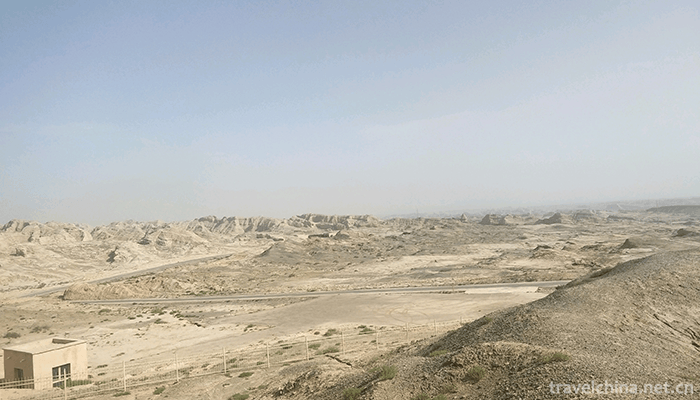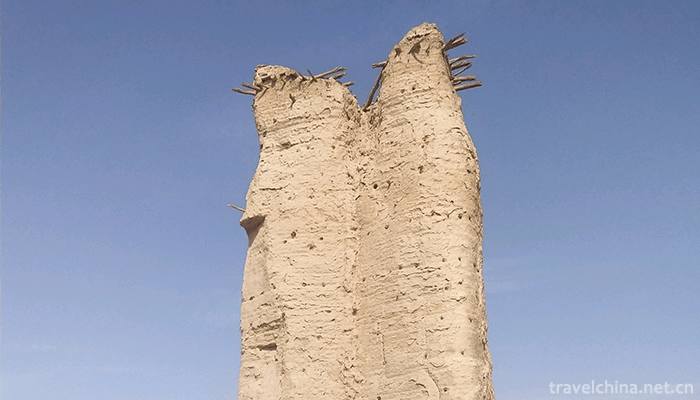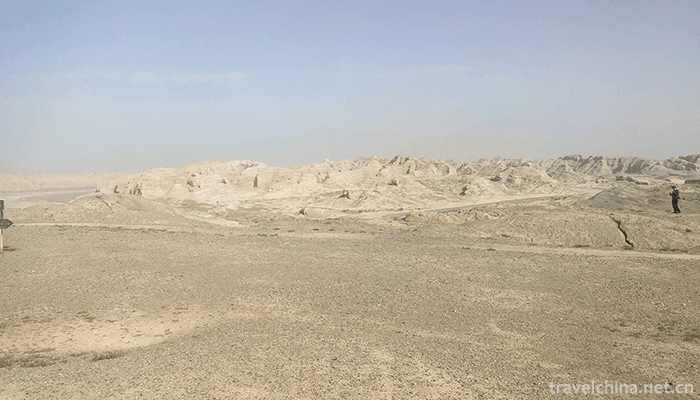Yangda Kuduktur Beacon Platform Site
Beacon also known as beacon platform, beacon platform, Yandun, pyrotechnic platform. If there were enemies, smoke in the daytime and fire in the evening were the quickest and most effective ways to transmit military information in ancient times.
The beacon is an ancient alarm system. It coexists with the Great Wall and forms a complete military defense system. But there are also independent early warning and defensive functions, the beacon fire platform in Xinjiang is the best example. The beacons in Xinjiang are all over the north and south of Tianshan Mountains. They are in line with the middle road and the North Road of the Silk Road, and play an important role in protecting the smooth flow of the Silk Road.
The Great Wall is a great invention of the Chinese people and has been proud of it for many generations. As early as the Spring and Autumn Period and the Warring States Period, Qi, Chu, Yan, Zhao, Qin and other kingdoms began to build the Great Wall. Qin Shihuang joined the former Yan, Zhao and Northern Qin border crossings and blockaded them for "more than 10,000 miles". He managed Hexi as a barrier to Huaxia and Wudi of Han Dynasty. He built barriers and pavilions to protect the silk traffic. Later, the repairs continued throughout the ages. By the Ming Dynasty, the construction of the Great Wall in Hexi reached its peak. Otherwise, how can there be such a scenic spot as Jiayuguan? Building the Great Wall is the embodiment of national strength. If you have a family, you have to repair it for fear of being cared about by thieves. It's not that you want to fix it. It needs silver and manpower to make it. The most complete early-warning defense system has been constructed by "steep and deep trenches, which connect with each other". Nowadays, all countries in the world are building new Great Wall as long as they have family background.
The beacon is a string of pearls on the Great Wall. When you see it, you think of the Olympic torch relay. It means the same thing. Delivery of information. Imagine how spectacular it was to find the first pier of the enemy fire, the second pier and the third pier, which were transmitted to Lanzhou and Chang'an. What an advanced way of information transmission was this in those days. It was really high-tech. There is still a beacon today, which is the wireless communication tower of Mobile Unicom. Along the Silk Road, a tower is erected twenty or thirty kilometers apart.
Famous beacon
Hami Silk Road Beacon
Hami region still retains 51 beacons of all ages, which is the largest and best preservation area of beacons in Xinjiang.
Among them, the number of beacons preserved in Balikun County is the largest, with a total of 29, while in Hami City and Yiwu County there are 19 and 3, respectively.
The earliest beacons in Hami area were built in Tang Dynasty. There are still four Tang beacons left in Hami. These are Laksumu beacons in Hami Fort 2, Xiamabrake beacons in Liushuquan, Santanghu beacons in Barikun and Kuothur Shona beacons in Yiwu Front Mountain. They have a history of more than 1200 years. The vast majority of the existing beacons are built in the Qing Dynasty. At present, the highest distribution density of beacons is the line from Balikun County to Salchok. There is one beacon every 2-3 kilometers. There are 13 beacons across the city. The city is like Censen's poem: "Cold post is far away as a point, border beacons look at each other", which is a magnificent sight of the Silk Road.
The shape of Salchok beacon and Barikun lakeside beacon are basically the same. The base is square and the body is prismatic with upward contraction. They are all rammed earth buildings. The rammed earth is intercalated with red willow branches and mostly uses circular timber frame.
Salchok beacon is 8 meters long, 8 meters wide and 7 meters high. There are four wooden sticks with a diameter of about 8 centimeters.
Barikun lakeside beacon is 400 meters away from the highway. It is tall and complete. Its length and width are over 10 meters, and its height is over 9 meters. The diameter of the round wood pierced in the chert body is up to 25 centimeters thick.
The beacon of Kuqa
The beacon of Kuche was built in the reign of Emperor Xuan of Han Dynasty, that is, after the establishment of the Western Regions Dufu in Wulei, it was perfected in the Tang Dynasty. There are three lines in the territory of Kuqa:
The first one is a military newspaper line of the capital of the Western Regions of the Han Dynasty to prevent the Huns from invading the South, starting from the West beacon of Luntai in the East and closing the barrier of Xizhiyangou in the west.
The second line starts from Luntai to the East and goes westward along National Highway 314, ending at Yangtuke Kuduk beacon in Xinhe County.
The third line runs northwest along the Weigan River from Tangwangcheng, Tarim Township. It coincides with the second line in Kositur, Kumutula in the West and Kezil Karahan Beacon in the northeast.
Although there are three Kuqa beacon lines, most of them are ruins. The most complete preservation of the site is Kizil Karahan beacon, located 10 kilometers northwest of the county town. The beacon plane is rectangular, gradually shrinking from the base to the trapezoid, about 13 meters high, rammed earth structure, building a lookout tower, and the remains of wooden bars. It is the earliest and best preserved beacon site on the northern Silk Road in the ancient Western Regions.
Maquan Bay Beacon
Maquan Bay beacon is located in the Gobi Corridor between Maquan Bay and Yanchi Bay, 11.5 kilometers west of Xiaofangpan City. It is 3 meters north of the plug wall. The beacon plane is rectangular with a bottom length of 8.35 meters, a width of 7.6 meters and a residual height of 1.87 meters. The southeast corner is covered with climbing steps. The castle was built on the east side of the beacon in the early period, and the gate of the castle opened to the west. There were three corridors and Suites in the castle, and all the rooms had stoves. After the fire was burned, it was abandoned and rebuilt on the south side of the beacon. The door opened southward. There is an east-west rectangular livestock pen 22.3 meters south of the city. There are 1221 bamboo slips unearthed from the Han Dynasty, which record the activities of entering and leaving Yumen Pass, Yumen Pass Hou and its jurisdiction, troops and fields. There are more than 300 other relics, including grain, linen paper, brush, stone inkstone, silk fragments, wool fragments, silk floss, linen cloth, flax shoes, bamboo knitting, lacquerware, wood, bone, iron, bronze, baht money, etc. According to the analysis, this site is the Marquis Governor's Office of Yumen in the Western Han Dynasty.
The Great Wall of Qi
During the investigation of the Great Wall of Qi Dynasty, the Chinese Communist Party found 13 sites of Fengxue, most of which were built on the peaks and high hills of the Great Wall, some on the hills and mounds about 500 meters outside the Great Wall, and some on the inside of the Great Wall.
Yangjiashan Beacon
Yangjia Mountain, located at the boundary between Changqing and Feicheng, is 293 meters above sea level. It is made of stone and its residual wall is 1 meter high.
Wannan Beacon
It is located 2500 meters north of Changqing Great Wall, east of 104 National Road and south of Wande Village. The existing 10-meter-high terrace is 31 meters long. The ignition point on the terrace is 6 meters high and its diameter is about 15 meters.
Ladder Hill Beacon
Located at the Western top of the ladder on the border between Licheng and Tai'an. Diameter 4 meters, stone wall collapsed, residual height 1 meter.
South Tianmen Beacon
On the top of the hill on the east side of the South Tianmen Gate, there is a circular beacon site with a diameter of 8 meters. The stone wall has collapsed and its residual height is 2.5 meters.
Jinyang Guan Bingzhao
At the top of the hill 700 meters east of Guandong in Jinyang is the site of beacon, which is called pyrotechnic platform locally. The building is now extinct and the foundation is recognizable.
Xijian Beacon
Located at 1700 meters west of Huangshiguan, on the West tip of 721.7 meters above sea level, the site is 15 meters in diameter and 1.5 meters in height.
Mulingguan beacon
There is a beacon site 250 meters east and west of Guancheng. After the collapse, the diameter was 15 meters and the height was 3 meters. When Japanese invaders invaded China, they built fortresses on the Dongpingzhao site, which is now called "ghost tower".
Nanshan beacon
Located on a hill 50 meters inside the Great Wall of Anqiu Majiawangnan Mountain. The site is 15 meters in diameter and 5 meters in height. The stone wall foundation still exists.
Great Wall Ling Fengtai
The Great Wall of Qi enters Dongguan Town of Juxian County in Sanleng Mountain, which is called Great Wall Ridge. It is 4.5 kilometers long from north to South and turns West to East in Dadianzi Village. The beacon tower is located on Gaofu, 400 meters outside the corner of the Great Wall of Qi. The northeast is 900 meters away from Dadianzi Village. The earthwork is oval. The site is 35 meters east-west, 21 meters north-south and 4 meters high. The local name is Fengtai.
Dashan beacon
On the Hilltop of Dashan Village, 500 meters southeast of Wanghu Town, Wulian County, at 172.5 meters above sea level, it is located outside the Great Wall of Qi, about 5 kilometers east of the Great Wall Ridge. The Earth-built circular beacon site is 25 meters east-west, 20 meters north-south and 5 meters high. The local name is Fengtai.
Beacon roof
Located on the top of a hill on the west side of Liuwang Town and Meixiang Highway in Jiaonan City, it is 177.7 meters above sea level and has a circular earth structure with a diameter of 30 meters and a height of 2.5 meters. It is called Beacon top locally. There is a large village named "Fengtai" 1000 meters east of the top of Fengtai, which evolved from "Fengtai".
Beacon in Yujiahe River
The last beacon is on the east side of the present bonded area of Huangdao Development Zone in Qingdao, 200 meters from the coast of the Great Wall. The earthen beacon site was encroached by surrounding farmland, cemetery and mechanized farming road. The site is 18 meters east-west, 8 meters north-south and 4.5 meters high.
Brief Introduction of Big Dun Beacon
Big pier beacon
It belongs to the Tang Dynasty road protection beacon, located near the Turpan-Toxon Highway, 22 kilometers northeast of Turpan City. The northern part of the city is Kuitutan, surrounded by saline-alkali meadows. Residual height is about 7 meters, length and width are about 10 meters, with red willow branches in the middle.




0 Questions
Ask a Question
Your email address will not be published.